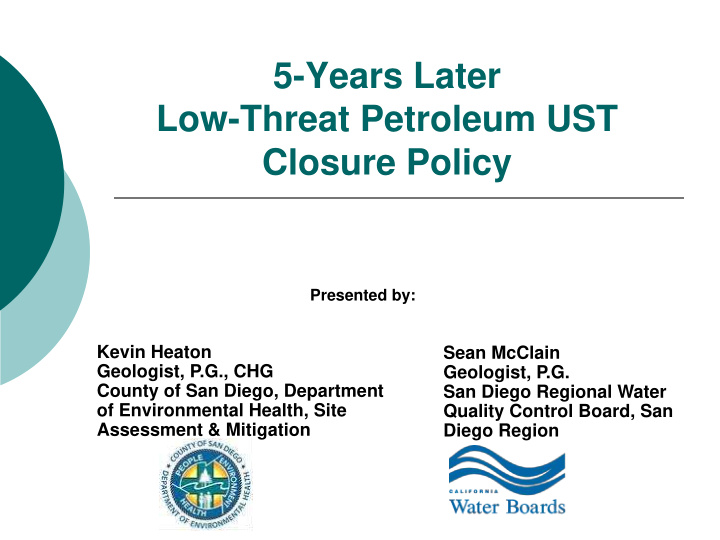



5-Years Later Low-Threat Petroleum UST Closure Policy Presented by: Kevin Heaton Sean McClain Geologist, P.G., CHG Geologist, P.G. County of San Diego, Department San Diego Regional Water of Environmental Health, Site Quality Control Board, San Assessment & Mitigation Diego Region
SWRCB Low-Threat Petroleum UST Closure Policy Focus on high-priority cases (such as impacted drinking water wells, human health, and sources of free product) Provide consistent regulation of the Policy throughout the state Path to Case Closure Plans for each open case, including specific milestones and timelines
LTC Policy Criteria Difficulties
Site Conceptual Model Extent of release in both soil and groundwater Definition of areas impacted by free product Data analysis of dissolved plume stability Quantify volume of residual impacted soil remaining Maps of dissolved plumes (BTEX and MTBE) and estimated time to reach MCLs
Free Product Removed to the Maximum Extent Practicable Free Product Removal Bailers are not effective Dedicated skimmers or hydrophobic bailers have been effective in sandy soils not silty or clayey soils Vapor Extraction and Dual Phase Extraction Effective where free-product is present High Vacuum Dual Phase Extraction Effective in tight formations
Free Product Removed to the Maximum Extent Practicable Free product removed to the maximum extent practicable in a manner that minimizes the spread of contamination into previously uncontaminated zones Migration shall be the predominant objective in the design of the free product removal system To make these evaluations the following methods shall be considered Monitoring the extent of the LNAPL body (usually using the apparent product thickness in monitoring wells) at a certain water level elevation over time Bail-down test Pilot testing (vapor extraction or DPE)
Free Product Removed to the Maximum Extent Practicable Additional removal or active remedial actions shall not be required by regulatory agencies unless Necessary to abate a demonstrated threat Dissolved phase plume is not stable Free product is migrating
UST Cases Closed with Free Product Non-beneficial use aquifers that posed no threat to human health Free-product under roads or near freeways that posed no threat to human health or the environment Free-product in beneficial use aquifers greater than 30 feet bgs that posed no threat to water supply wells, future groundwater use, human health, or the environment
Questions
Recommend
More recommend